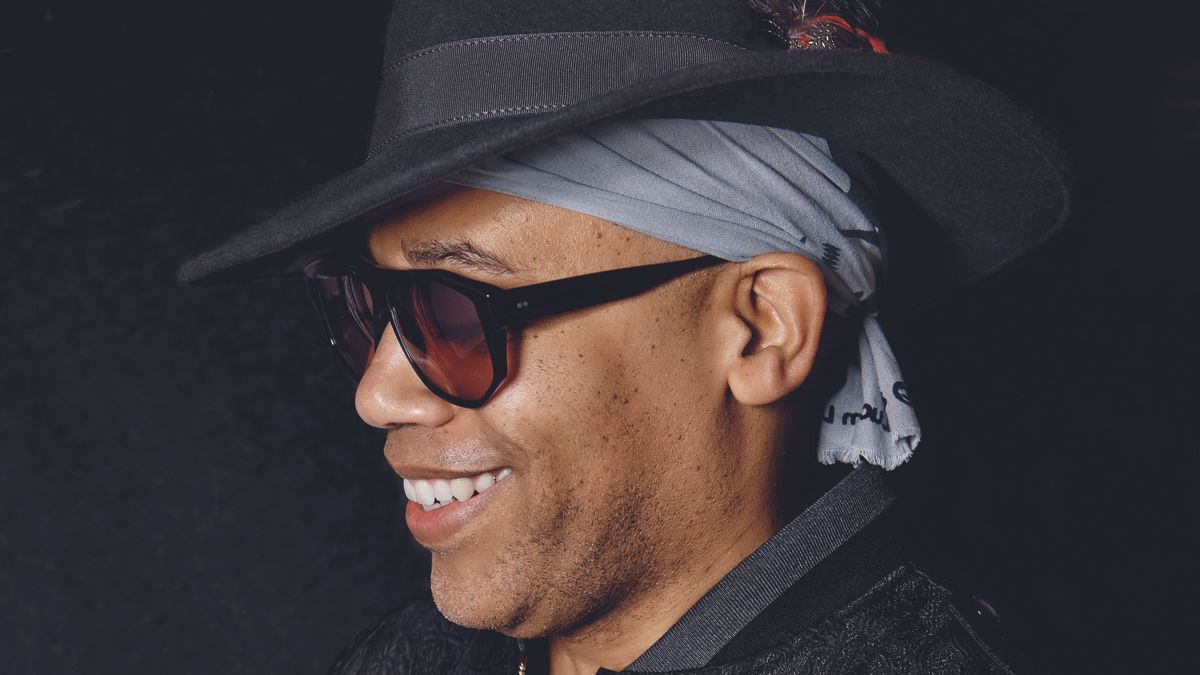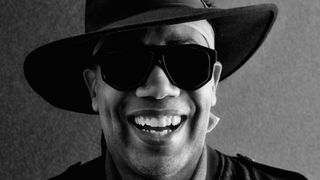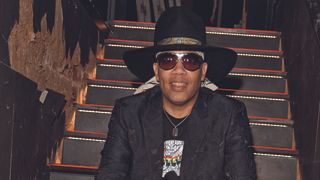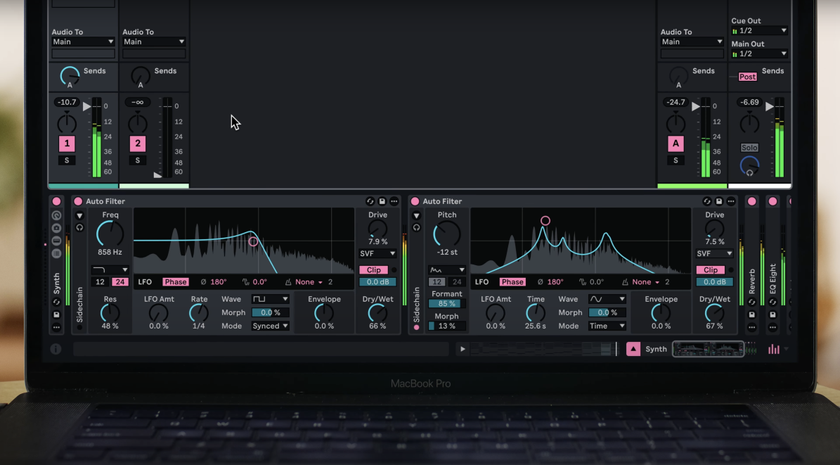Carl Craig: "I only make use of around 5% of what each DAW is capable of"
The Detroit techno pioneer on his influences, his love of gear, and broadening his musical horizons

When you sit down for an afternoon with Carl Craig, it’s not long before Detroit glides into the conversation. Born there in 1969, it’s the place he’s always called home. It’s also where he first heard the music of other local kids like Derrick May, Kevin Saunderson and Juan Atkins; the music that came to be known as Detroit techno. And it’s where he made and released his first record, 1989’s Neurotic Behavior.
But Craig’s very first memory of the city goes back much further. To the early '70s, when he was standing on the corner of Woodward Avenue and Interstate 75, cheering the Thanksgiving Day Parade with his parents.
“All the noise and dancing was happening on the street, but, for some reason, I looked up,” says Craig. “This building had a big ‘M’ on the front. I didn’t know what it was or what it stood for, but it touched me in some way. When I looked up at that ‘M’, I felt I was looking at Detroit. Looking at the soul of Detroit. Years later, I realised that it was the Motown building.”
Carl Craig is relaxing backstage at London’s Royal Albert Hall. Craig is in the UK to talk about his forthcoming live show at the prestigious venue. The Royal Albert Hall has played host to many leftfield legends such as Kraftwerk, Hendrix and the Daleks, but its reputation was built on names like Rachmaninoff, Elgar and Coleridge-Taylor. It has classical music in its blood. Well… in its bricks and mortar.
It seems the perfect venue, then, for the debut UK performance of Craig’s Versus project, which features tracks from his back catalogue, adapted for synths, decks and full orchestra. For this show, he’s joined by pianist Kelvin Sholar, who’s worked with everyone from Babyface and Q-Tip to Sean Lennon and Common; and the Chineke! Orchestra, the first professional orchestra in Europe with a majority of black and minority ethnic musicians.
“Versus goes back to 2008, when [Juilliard piano prodigy] Francesco Tristano got stuck into some of my songs. Taking them from the electronic world into this strange classical/electronic crossover world. I guess I’d never really considered my music as ‘classical’, but I loved the idea that we could take my songs in another direction.
“For me, that’s what music has always been about. Whenever I see an envelope, I just have to keep pushing and pushing.”
Get the MusicRadar Newsletter
Want all the hottest music and gear news, reviews, deals, features and more, direct to your inbox? Sign up here.

How did the idea for Versus first come into being? Were you always ‘in charge’ or was there a two-way process between you and Francesco?
“It was a two-way process, but there was definitely a period where I let Francesco do what he does. I mean, c’mon… he’s a Juilliard kid! He was looking at the music in all kinds of different ways. The parts weren’t written for violin or woodwind, but I trusted Francesco to do what needed to be done. I know my musical capacity and I know what I’m capable of. Francesco, on the other hand, is a fucking awesome musician and it was a joy to watch him introduce all these new sounds.
“Over the years, the arrangements have evolved quite a lot. The Royal Albert Hall show will feature the Chineke! Orchestra and Kelvin Sholar, who comes from a much more jazz-orientated background. Kelvin sees the music in a different way and that means the performances have new elements. And I feel much more involved in these recent changes because I’ve got a lot more experience than I had in 2008. I have a much better idea of what will work and what won’t.”
What have you got up there on stage?
“The computer running Ableton Live, with an Arturia MatrixBrute, which is what I do all the soloing on. And NI Maschine.”
And a very nice suit, might we add. There’s some great footage of you rocking a snazzy grey two-piece!
“Ha ha! You’ve got the whole orchestra in tuxedos… it’s not like I can turn up there in jeans and a T-shirt!”
Presumably it feels different to a club or festival gig?
“Of course, but the power of the music is still there. Ever since I first started making my own songs, I’ve always tried to make sure I don’t keep the music locked in a box. I’m not a ‘mono’ person; I’m a ‘poly’ person.
“I can’t just think about one sound or one style every day of the week. People say, ‘I only listen to techno’ or ‘I only listen to house’ and I feel sorry for them because they’re missing out on all this other wonderful music. Imagine saying that you were only going to see the colour blue. Think about how dull the world would be if you only had one colour.
“Music is a bit like time travel… like that show Quantum Leap. If you push today’s music into a box and keep it locked away, then it won’t have a chance to affect what’s going to happen in the future. If we experiment today, our experiments might change the future.
“When I made Bug In The Bass Bin, there were a whole lot of jazz influences that were going around my head and they automatically fed into the music. Some people questioned the sound of that track but, from what I’ve been told, Goldie heard it and said, ‘I want that sound’. Bug In The Bass Bin became part of the story of drum ’n’ bass.
“One of the reasons that electronic music exists is that it allows you to break the rules. Synths allow you to make sounds that no one else has made. It doesn’t matter if someone tells you it’s wrong or it’s not real music. So what? Music is about making a sound that you like. That’s all that matters.”

You played guitar as a kid but, from what I’ve read, it was primarily electronic music – in particular, the sound of the synthesizer – that was what actually made you want to write songs.
“Gary Numan’s Cars was a big song for me. It was huge on urban radio in the US. Then, of course, you had Kraftwerk. Trans Europe Express had been accepted by black and latino radio, and they [Kraftwerk] seemed to expand way beyond that with Man Machine. There was a lot of funk in that album… a lot of funk.
“Image-wise, they were these un-funky dudes, but the guy they brought in to engineer Man Machine was Leanard Jackson. He’d worked with Norman Whitfield… yeah, the Norman Whitfield. The Temptations’ Papa Was A Rolling Stone, Car Wash and a lot of Rose Royce stuff, Marvin Gaye. Suddenly, you’ve got Whitfield’s engineer working with Kraftwerk. A meeting of two worlds.
“What else was there? George Clinton and Parliament, The Gap Band, Roger Troutman and Zapp. When people talk about synth pioneers, Kraftwerk is the name that always comes up, but Roger Troutman was one of the greatest artists to ever touch a synth.
“And Sun Ra! You’ve got Sun Ra experimenting with the Moog. He was key to what was happening to the synth. His song, Space is the Place… the use of different stage names. Using different names was all about shedding the restrictions of slavery. You had black people in poverty in the US and they were always talking about not wanting to be ‘here’. Not wanting to be on this planet. They wanted to go to heaven, to a place where there were no restrictions. No slavery.
Gary Numan’s Cars was a big song for me. It was huge on urban radio in the US.
“The synth was part of that. It was an instrument that had no restrictions, no limits. You didn’t have to learn it like the piano. You could just sit down and start creating sounds from outer space. Like Sun Ra said, “space is the place”. The synth would take you to outer space. Take you away from the drudgery and the poverty. It was a tool that was eagerly utilised within black music.”
What a time to be listening to music!
“Definitely. And it wasn’t long after that when I first heard Derrick May’s radio show on WJLB. Hearing Strings of Life [released by May under the name, Rhythim Is Rhythim]. That’s when my mind was finally blown. But it was also when my life finally made sense.”
We’d imagine that a lot of people’s lives suddenly made sense when they heard Detroit techno.
“It wasn’t just listening to the music. It was the instruments… the synth, the drum machine, the sampler. A cousin of mine was the first person I knew who had a synth. I remember going around to his house and there was a Sequential Circuits Six-Trak, a DX7 and a 909. I can still feel that thrill when I pushed down a key on the Six-Trak. I wanted to be in that gang… I wanted to make techno music.”
You mentioned Gary Numan and Kraftwerk earlier on, and there are some people who will argue that the sound of Detroit had a distinctly European flavour. The music from Chicago and New York, on the other hand, was American. Too simplistic?
“Way too simplistic. Chicago had its own European influences… Italian disco was huge. If you’re looking for a theory behind the sound of Detroit, the best place to start is with a very early Juan Atkins interview. He was asked about the music he was making, and he said: ‘the main idea was that we didn’t want to sound like Berry Gordy and Motown’.
“Even to this day, when I tell people that I’m a musician from Detroit, they immediately assume I’m a soul guy signed to Motown. When we were growing up, Detroit was dominated by Motown and we were kind of rejecting that sound. We wanted to break new ground.”
Gear-wise, how long did it take for you to get started?
“The early mantra was beg, borrow or steal. That was the only way I could make music. I had a Prophet 2000, an Alesis MMT-8 sequencer and a four-track that I borrowed and eventually stole. Make the drum sounds, record the drums. Make the bass sounds, record the bass. It really was that basic.
“The first time that I got a hold of a computer was probably around 1991. It was one of those Macintosh Classics, running… I think it was Performer. The computer wasn’t really such a big thing in Detroit. We preferred working with sequencers like the Alesis. Derrick May never used a computer. Juan [Atkins] took a long time. Kevin [Saunderson] was there earlier than the rest of us because his brother was a computer programmer.
“Personally, I liked the way the Alesis made my music sound. If you write with a standalone sequencer, you write in a particular way. If you write with an MPC3000, you write in a particular way. Very different to working with a DAW like Logic or Ableton Live.”
HARDWARE
Apple Mac
Roland SH-101
Pioneer Toraiz AS-1
Studio Electronics Omega-8
Presonus Faderport 16
Sontec MEP-250EX
Lexicon PCM 41
Arturia MatrixBrute
Native Instruments Maschine
SOFTWARE
Ableton Live 10
Harrison Mixbus
Arturia V Collection
Roland Cloud
FabFilter Pro-Q 3
Spectrasonics Omnisphere 2
And which one do you use?
“I hate ’em all! Ha ha! My philosophy is that you should use anything that will get the job done. I’ve pretty much used every DAW out there. Logic, Pro Tools, FL Studio, Ableton… and I also use Harrison Mixbus.
“The harsh reality is that I only make use of around 5% of what each of those DAWs is capable of. But I can get them to do the things that I need them to do.”
Could you live without a computer? Go back to the sequencer days?
“Are you kidding! I read Computer Music religiously, and I am a plugin hoarder. I’m always bitching about this on Twitter, but I can’t seem to stop. If there’s a new compressor coming out next week, I have to have it. I would say I’ve got 30 or more compressors on my computer. What do I need 30 compressors for?
“If you’re on the road all the time – which I am – what you actually need is a compressor that will make your music sound correct when you’re using headphones. But if I read about a new one and it sounds like it will make my life a little bit easier or there’s a special deal on it, I will buy it.
Maschine is getting interesting, but still hasn’t reached its full potential.
“And, like any hoarder, I never really get rid of anything. Even if it’s a plugin that I never use, I still end up keeping it. Hardware, as well. More or less every bit of hardware that I’ve ever owned is still in the studio. My first synth, my first guitar, old four-tracks.”
Yeah… there are some pictures out there of you sitting in front of a very well-stocked studio. And you’ve got some seriously tasty analogue synths. Have you investigated the soft synth world?
“Oh, yeah! Like I said, I’m a hoarder. Omnisphere is a no-brainer. Maschine is getting interesting, but still hasn’t reached its full potential. The Roland and Arturia collections. I like libraries of sounds… something like the Arturia Analog Lab. You can flick through a whole heap of sounds without having to change plugins. That makes sense to me.
“On the hardware side, I do have some modern stuff, too. It’s not all vintage. The Pioneeer/Dave Smith Toraiz AS-1 doesn’t seem to do a whole lot when you first look at it, but after a while you realise that it does everything. The Studio Electronics Omega8 is pretty cool.
“Better than the old synths? Hmm… even after all these years, I still love my SH-101. It cost me 50 bucks and the guy who sold it to me was so mad when he found out how much they were worth a couple of years later. Maybe that’s why I love it so much. It only cost me 50 bucks.”
And is that the one bit of gear you couldn’t live without?
“No, the one bit of gear I couldn’t live without is my room… my studio room. When you’re starting out and you’re making your first tunes in your bedroom, it’s all about raw energy and ideas. But when you start stepping up the ladder, you begin to realise the importance of the right room. It sounds kinda boring, but that’s the best thing I’ve learned in all the years I’ve been making music. You can have 100,000 bucks worth of Eurorack gear, a fully-loaded Mac and the best PMC monitors available, but if your room isn’t up to the job, the whole thing will fall apart.”


Computer Music magazine is the world’s best selling publication dedicated solely to making great music with your Mac or PC computer. Each issue it brings its lucky readers the best in cutting-edge tutorials, need-to-know, expert software reviews and even all the tools you actually need to make great music today, courtesy of our legendary CM Plugin Suite.












